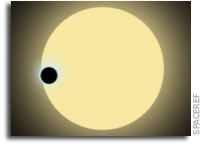On detecting terrestrial planets with timing of giant planet transits

http://images.spaceref.com/news/extrasolar.40.jpg
Astrophysics, abstract
astro-ph/0412032
From: Eric Agol [view email]
Date (v1): Wed, 1 Dec 2004 20:13:45 GMT (176kb)
Date (revised v2): Mon, 13 Dec 2004 07:37:09 GMT (176kb)
On detecting terrestrial planets with timing of giant planet transits
Authors:
E. Agol,
J. Steffen (University of Washington),
R. Sari (Caltech),
W. Clarkson (Open University)
Comments: 21 pages, 9 figures, submitted to MNRAS
The transits of a planet on a Keplerian orbit occur at time intervals exactly
equal to the period of the orbit. If a second planet is introduced the orbit is
not Keplerian and the transits are no longer exactly periodic. We compute the
magnitude of these variations in the timing of the transits, dt. We investigate
analytically several limiting cases: (i) interior perturbing planets with much
smaller periods; (ii) exterior perturbing planets on eccentric orbits with much
larger periods; (iii) both planets on circular orbits with arbitrary period
ratio but not in resonance; and (iv) planets on initially circular orbits
locked in resonance. Case (iv) is perhaps the most interesting case since some
systems are known to be in resonances and the perturbations are the largest. As
long as the perturber is more massive than the transiting planet, the timing
variations would be of order of the period regardless of the perturber mass!
For lighter perturbers, we show that the timing variations are smaller than the
period by the perturber to transiting planet mass ratio. An earth mass planet
in 2:1 resonance with a 3-day period transiting planet (e.g. HD 209458b) would
cause timing variations of order 3 minutes, which would be accumulated over a
year. These are easily detectable with current ground-based measurements. For
the case of both planets on eccentric orbits, we compute numerically the
transit timing variations for several cases of known multiplanet systems
assuming they were edge-on. Transit timing measurements may be used to
constrain the masses and radii of the planetary system and, when combined with
radial velocity measurements, to break the degeneracy between mass and radius
of the host star. (abstract truncated)
Full-text: PostScript, PDF, or Other formats
References and citations for this submission:
SLAC-SPIRES HEP (refers to ,
cited by, arXiv reformatted);
CiteBase (autonomous citation navigation and analysis)
Which authors of this paper are endorsers?








